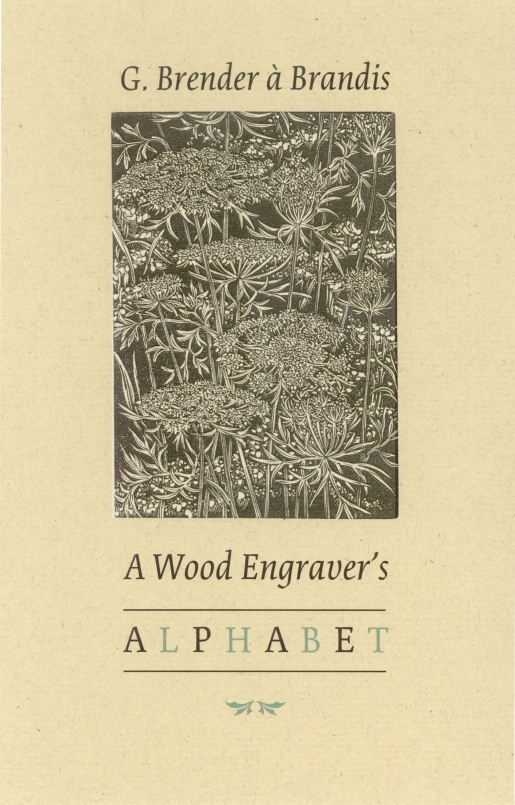![]() Author: Gerard Brender à Brandis
Author: Gerard Brender à Brandis
Title: A Wood Engraver’s Alphabet
Publisher: The Porcupine’s Quill
Media type: Trade paperback, 64 pages
Release date: August 2008
Reading period: November 2008
ISBN-13: 978-0-889843110
Category: Art; Alphabet books
 The first thing that strikes you about A Wood Engraver’s Alphabet is that it is a beautifully made book. The texture of the cover and the paper delight both hands and eyes. The paper is a warm ecru colour and of very heavy weight, an excellent ground on which to display the prints. The play between dark and light in the prints themselves is fascinating. Brender à Brandis creates an incredible amount of visual texture and suggestion of different materials (wood, petal, stalk, leaf, ground cover, stamens) in his engravings. The end papers are a green between olive and moss, and the signatures are sewn, not glued.
The first thing that strikes you about A Wood Engraver’s Alphabet is that it is a beautifully made book. The texture of the cover and the paper delight both hands and eyes. The paper is a warm ecru colour and of very heavy weight, an excellent ground on which to display the prints. The play between dark and light in the prints themselves is fascinating. Brender à Brandis creates an incredible amount of visual texture and suggestion of different materials (wood, petal, stalk, leaf, ground cover, stamens) in his engravings. The end papers are a green between olive and moss, and the signatures are sewn, not glued.
This book is Gerard Brender à Brandis’ love letter to the botanicals in his world. The form is a simple alphabet book, but instead of illustrating the letter itself the artist has chosen to create a wood engraving of a plant whose name begins with that letter. On the lower edge of the blank left page, facing the print on the opposite page, the name of the plant is displayed, both the common name and the botanical name. The engravings themselves on the right page vary in size and shape, and in placement on the page. Some are slender tall rectangles; others are squares. In each the delicate, lyrical interplay between negative and positive space, between black and white, creates depth and light. Some almost fill the right page, while others seem to float in a vast ecru frame.
I have only one minor quibble with the book, and it rests in the choice of plant for certain illustrations. At times the plant is chosen for its Latin name, other times for its common name, yet other times for the colour. For example, ‘Nodding Trillium’ illustrates the letter N instead of T, as one would expect. And yet the quibble is so very minor, because the subjects Brender à Brandis has chosen to engrave offer so much visual interest that in the end what they are or what they’re called doesn’t matter. If he was called or inspired to illustrate a certain plant instead of something else, then there was a reason for it, and the result is so beautiful that the quibble is forgotten in the subsequent examination of the artwork.
What I appreciated most was the brief introduction written by Brender à Brandis, which talked about the physical process of production and his creative artistic process. He talks about being led to use certain woods for certain engravings, how he chose what plants to engrave, and the delight humanity takes in flowers,
It’s a slender little paperbound volume priced at $16.95. The production quality is very high. It’s an exquisite little art book that would make a lovely gift for someone interested in engraving or for a lover of botanicals. It does require a relaxed and open mind when one sits down to read it, however, and plenty of time to pore over the engravings. I will absolutely go on to look up Brender à Brandis’ other books, particularly A Gathering of Flowers from Shakespeare.
Many thanks to Mini Book Expo and The Porcupine’s Quill, through whom I acquired the review copy of this book.
Publisher web site: http://www.sentex.net/~pql
Author web site: n/a
So glad to see that you liked this book! I really appreciate Porcupine’s Quill production values too; it’s nice to see such obvious care (ie: sewn signatures!) Brender a Brandis is a wonderful artist, and if you’re ever in Stratford you can drop into his studio/house and meet him at work.